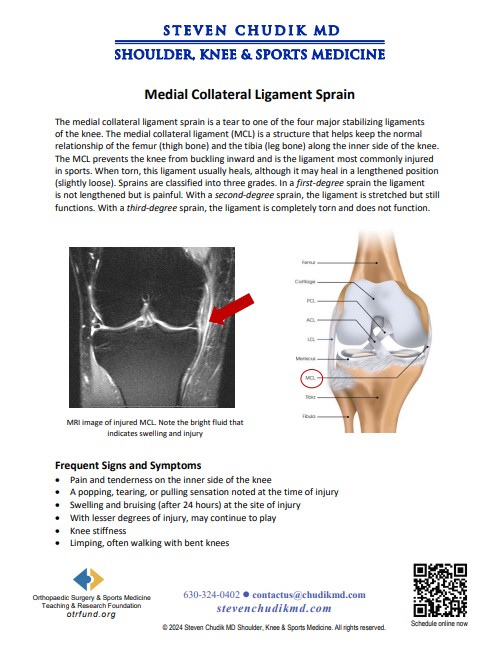 Don’t drink caffeine for an energy boost---climb the stairs
Don’t drink caffeine for an energy boost---climb the stairs
Home / Knee Surgeon Chicago Illinois / Medial Collateral Ligament (MCL) Sprain
The medial collateral ligament sprain is a tear to one of the four major stabilizing ligaments of the knee. The medial collateral ligament (MCL) is a structure that helps keep the normal relationship of the femur (thigh bone) and the tibia (leg bone) along the inner side of the knee. The MCL prevents the knee from buckling inward and is the ligament most commonly injured in sports. When torn, this ligament usually heals, although it may heal in a lengthened position (slightly loose). Sprains are classified into three grades. In a first-degree sprain the ligament is not lengthened but is painful. With a second-degree sprain, the ligament is stretched but still functions. With a third-degree sprain, the ligament is torn and does not function.
MCL sprains are caused by force that exceeds the strength of the ligament. Most commonly this injury is the result of a direct blow to the outer side of the knee, usually while the foot is on the ground. This injury may also be a result of a non-contact injury.
Initial treatment consists of medications and ice to relieve pain and reduce the swelling of the knee. Walking with crutches until you walk without a limp is often recommended (you may put full weight on the injured leg). Your physician may recommend a knee brace with a hinge to help regain knee motion while protecting the MCL. Range-of-motion, stretching, and strengthening exercises may be carried out at home, although referral to a physical therapist or athletic trainer is usually recommended. Rehabilitation of MCL sprains generally concentrates on reducing knee swelling, regaining knee range of motion, regaining muscle control and strength, and a short period of bracing. For severe MCL sprains or those associated with other knee ligament injuries, surgery may be recommended.
Learn More
 New ACL arthroscopic procedure by Dr. Steven Chudik lets active kids stay active
New ACL arthroscopic procedure by Dr. Steven Chudik lets active kids stay active
Dr Steven Chudik founded OTRF in 2007 to keep people active and healthy through unbiased education and research. Click to learn about OTRF’s free programs, educational opportunities and ways to participate with the nonprofit foundation.
1010 Executive Ct, Suite 250
Westmont, Illinois 60559
Phone: 630-324-0402
Fax: 630-920-2382
(New Patients)
550 W Ogden Ave
Hinsdale, IL 60521
Phone: 630-323-6116
Fax: 630-920-2382
4700 Gilbert Ave, Suite 51
Western Springs, Illinois 60558
Phone: 630-324-0402
Fax: 630-920-2382

© 2025 © 2019 Copyright Steven Chudik MD, All Rights Reserved.
